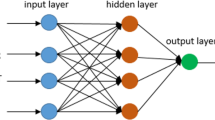Abstract
Wireless sensor networks are susceptible to various Denial-of-Service attacks due to their open deployment. Jamming attack at the physical layer is a type of Denial-of-Service attack in which an adversary node prevents channel access or disrupts the communication between the nodes by emitting noise signals. Due to this, the compromised nodes are interrupted either from sending out packets or receiving packets. As these nodes are unaware of the intrusion, they continuously attempt to access the jammed channel and retransmit lost packets resulting in energy drainage. This energy depletion though primarily leads to node failure, it ultimately reduces network lifetime enforcing intrusion detection. With this intention, a hybrid algorithm based on Fuzzy logic and Ant Colony Optimization for detection of jamming attack is proposed. Detection of jammed node is through fuzzy logic and thereon for successful data routing, Ant Colony Optimization is used. The proposal is simulated in MATLAB and the results are compared with the Ant Colony Optimization technique proposed earlier. The results confirm the supremacy of the proposed hybrid optimization technique over the Ant Colony Optimization.









Similar content being viewed by others
References
Akyildiz, I. F., Su, W., Sankarasubramaniam, Y., & Cayirci, E. (2002). Wireless sensor networks: A survey. Computer Networks, 38, 393–422. https://doi.org/10.1016/S1389-1286(01)00302-4.
Mpitziopoulos, M., Gavalas, D., Konstantopoulos, C., & Pantziou, G. (2009). A survey on jamming attacks and countermeasures in WSNs. IEEE Communications Surveys & Tutorials. https://doi.org/10.1109/SURV.2009.090404.
Li, M., Koutsopoulos, I., & Poovendran, R. (2010). Optimal jamming attack strategies and network defense policies in wireless sensor networks. IEEE Transactions on Mobile Computing, 9, 1119–1133. https://doi.org/10.1109/TMC.2010.75.
Xu, W., Trappe, W., Zhang, Y., & Wood, T. (2005). The feasibility of launching and detecting jamming attacks in wireless networks. In Proceedings of the 6th ACM international symposium on mobile ad hoc networking and computing, MobiHoc (pp 46–57). https://doi.org/10.1145/1062689.1062697.
Poisel, R. A. (2004). Modern communications jamming principles and techniques. Norwood: Artech House.
Poisel, R. A. (2008). Foundations of communications electronic warfare. Norwood: Artech House.
Xu, W., Ma, K., Trappe, W., & Zhang, Y. (2006). Jamming sensor networks: Attack and defense strategies. IEEE Network. https://doi.org/10.1109/MNET.2006.1637931.
Xu, W., et al. (2004).Channel surfing and spatial retreats: Defenses against wireless denial of service. In Proceedings of ACM workshop (pp. 80–89). https://doi.org/10.1145/1023646.1023661.
Mitziopoulos, A., Gavalas, D., Konstantopoulos, C., & Pantziou, G. (2008). JAID: An algorithm for data fusion and jamming avoidance on distributed sensor networks. Pervasive and Mobile Computing, 5(2), 135–147. https://doi.org/10.1016/j.pmcj.2008.06.001.
Wood, D., Stankovic, J. A., & Son, S. H. (2003). JAM: A jammed-area mapping service for sensor networks. In Proceedings of 24th IEEE international real-time system symposium (pp. 286–297). https://doi.org/10.1109/real.2003.1253275.
Cagalj, M., Capkun, S., & Hubaux, J.-P. (2007). Wormhole-based anti-jamming techniques in sensor networks. IEEE Transcations on Mobile Computing, 6(1), 100–114. https://doi.org/10.1109/TMC.2007.250674.
Sasikala, E., & Rengarajan, N. (2015). An intelligent technique to detect jamming attack in wireless sensor networks (WSNs). International Journal of Fuzzy Systems. https://doi.org/10.1007/s40815-015-0009-4.
Hemavathi, N., & Sudha, S. (2014). A fuzzy based predictive cluster head selection scheme for wireless sensor networks. In the proceedings of 8th international conference on sensing technologgy and International Journal on Smart Sensing and Intelligent Systems, 560–567.
Nagpal, S. K., & Sudha, S. (2015). Two-level fuzzy based fire prediction scheme using wireless sensor network. In Proceedings of IEEE international conference on advances in computing and communication. https://doi.org/10.1109/icacce.2015.105.
Misra, S., Singh, R., & Mohan, S. V. (2010) Information warfare-worthy jamming attack detection mechanism for wireless sensor networks using a fuzzy interference system. http://cache.jourlib.org/cache?m=8F63B2294C981FDBD15CD6A8F2F768F1.pdfSensors. https://doi.org/10.3390/s100403444.
Rajani, M., & Lisa, A. O. (2006). Jamming attack detection and countermeasures in wireless sensor network using ant system. SPIE. https://doi.org/10.1117/12.666330.
Dorigo, M., & di Caro, G. (1999). Ant colony optimization: A new meta-heuristic. In Proceedings of congress on evolutionary computation (pp. 1470–1477). https://doi.org/10.1109/cec.1999.782657.
Zadeh, L. A. (1965). Fuzzy sets. Information and Control, 8, 338–353.
Umamaheswari, D., Meenalochani, M., & Sudha, S (2016). Influence of the cluster head position on the lifetime of wireless sensor network—A case study. In 2nd IEEE international conference on next generation computing technologies (NGCT). https://doi.org/10.1109/ngct.2016.7877445.
Hemavathi, N., Nagpal, S. K., & Sudha, S. (2017). Impact of rate of recurrent communication of sensor node on network lifetime in a wireless sensor network. IET Science, Measurement and Technology. https://doi.org/10.1049/iet-smt.2016.0290.
Meenalochani M, Sudha S (2014) Fuzzy based estimation of received signal strength in a wireless sensor network. In Proceedings of the 3rd ACM international symposium on women in computing and informatics (pp. 624–628). https://doi.org/10.1145/2791405.2791543.
Author information
Authors and Affiliations
Corresponding author
Additional information
Publisher's Note
Springer Nature remains neutral with regard to jurisdictional claims in published maps and institutional affiliations.
Rights and permissions
About this article
Cite this article
Meenalochani, M., Sudha, S. Jammed Node Detection and Routing in a Multihop Wireless Sensor Network Using Hybrid Techniques. Wireless Pers Commun 104, 663–675 (2019). https://doi.org/10.1007/s11277-018-6042-5
Published:
Issue Date:
DOI: https://doi.org/10.1007/s11277-018-6042-5




